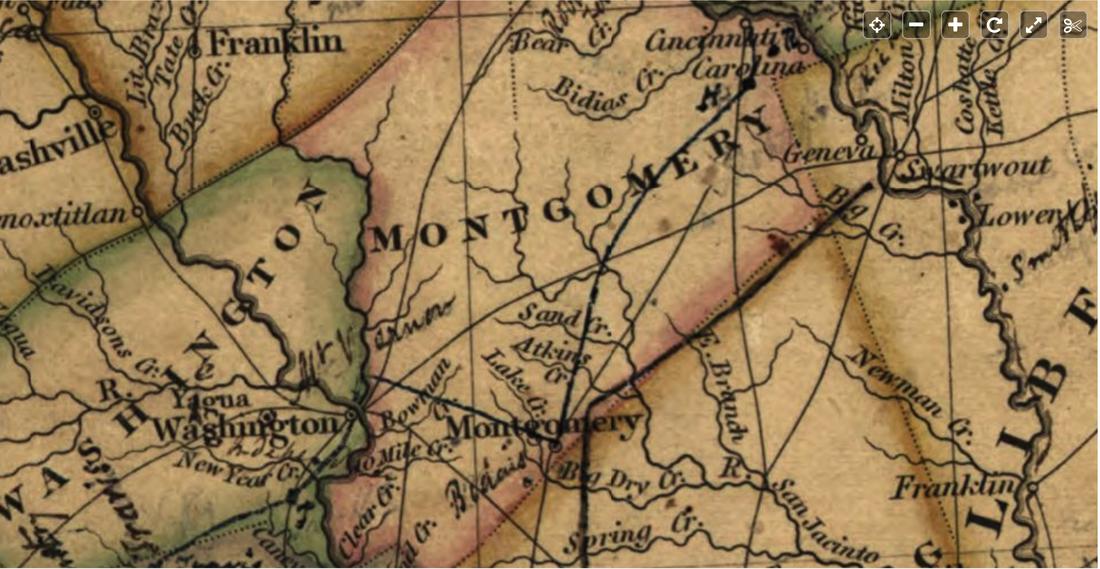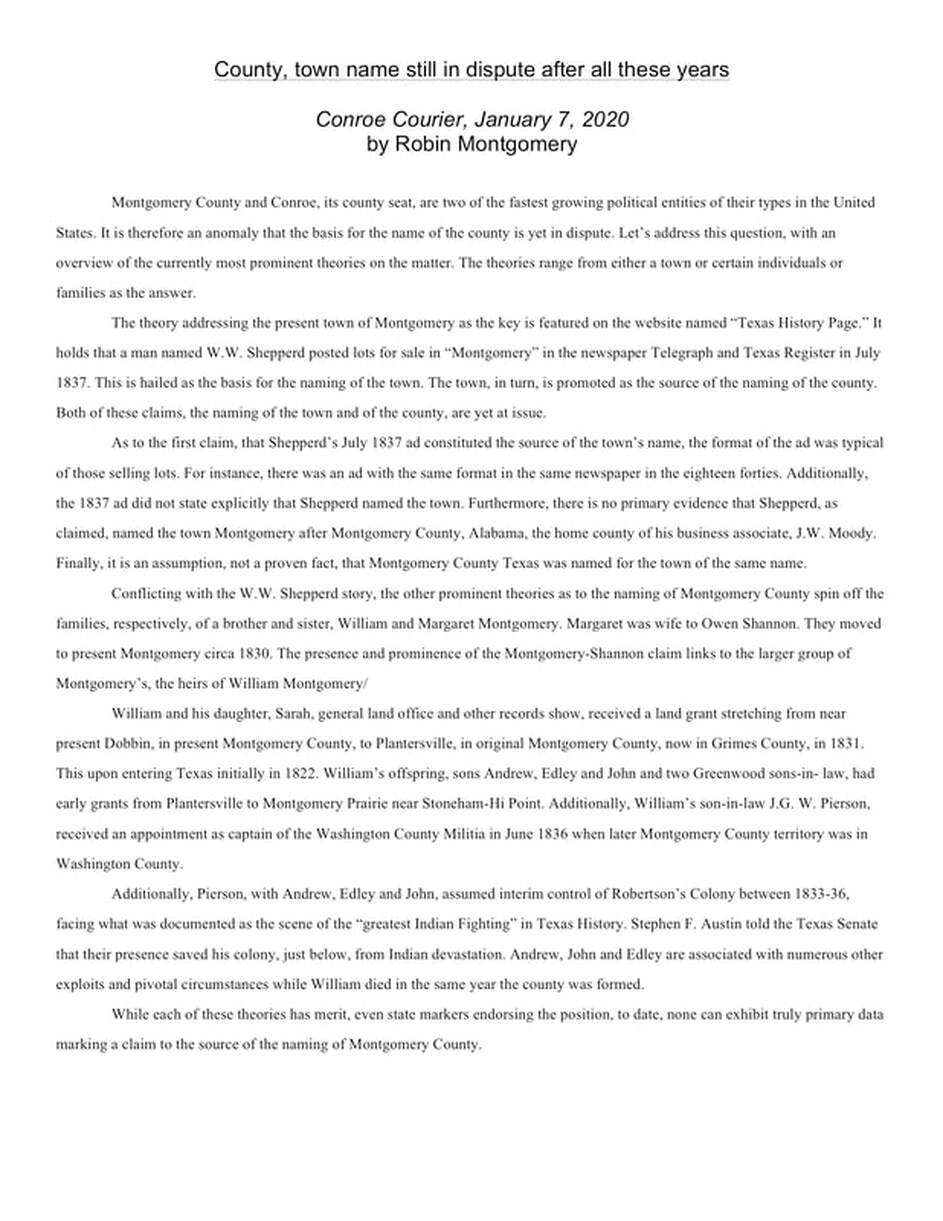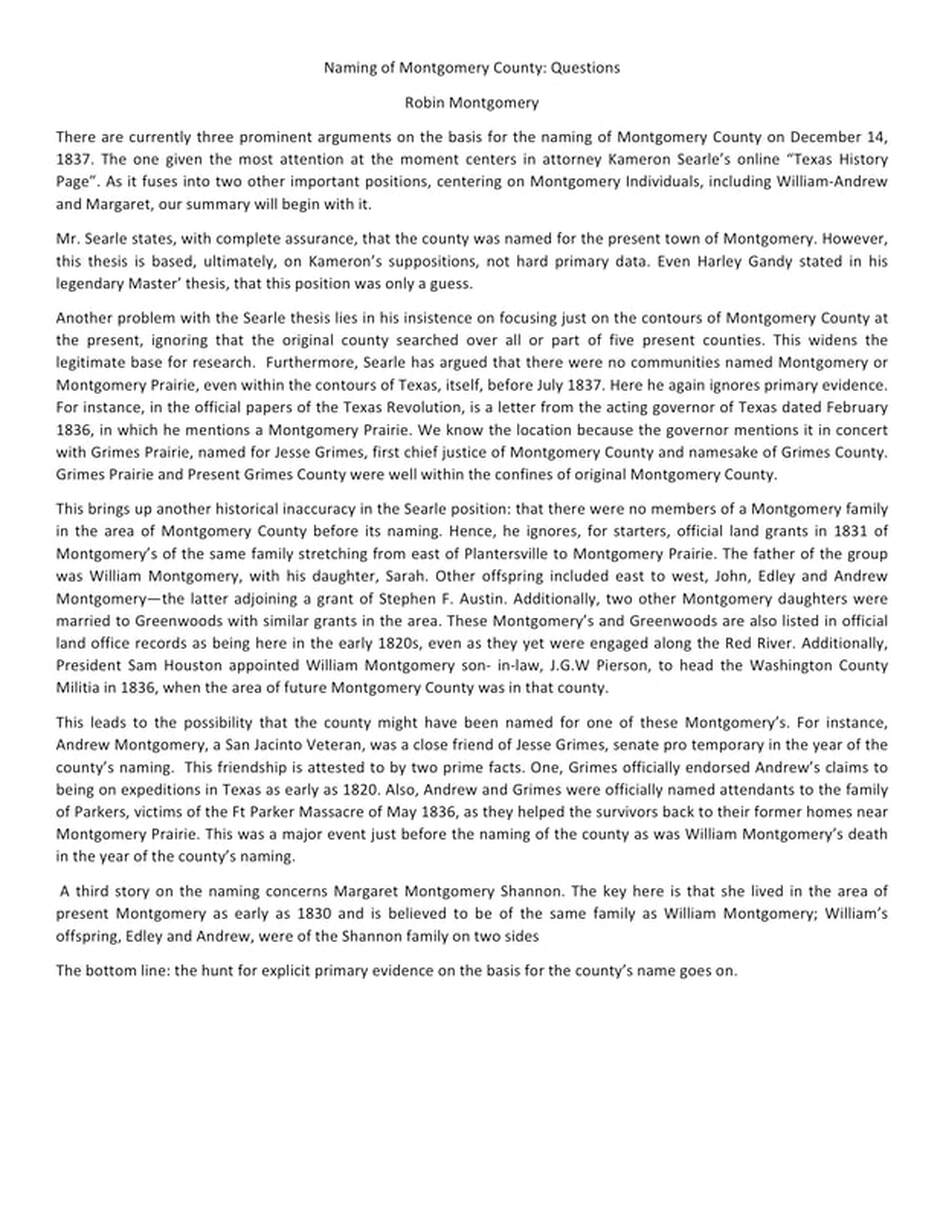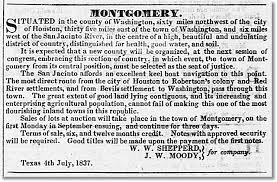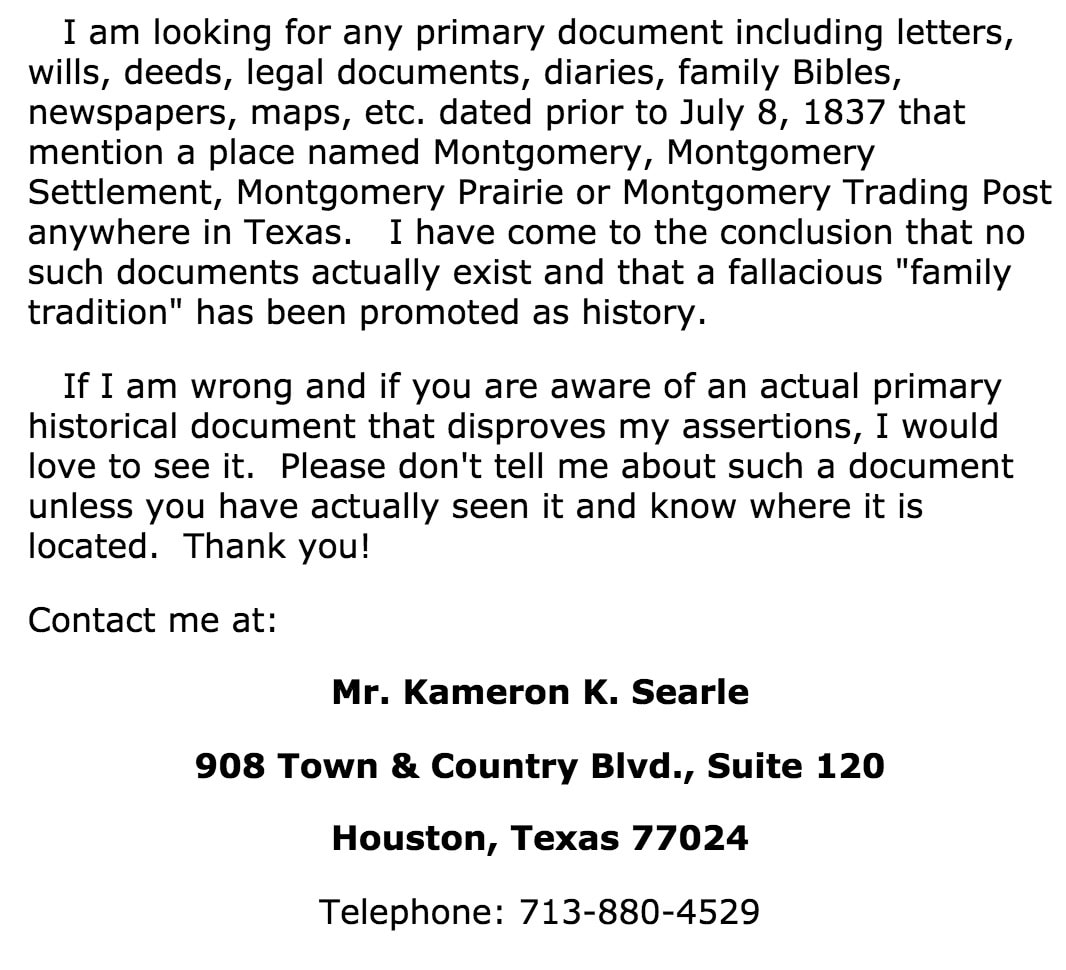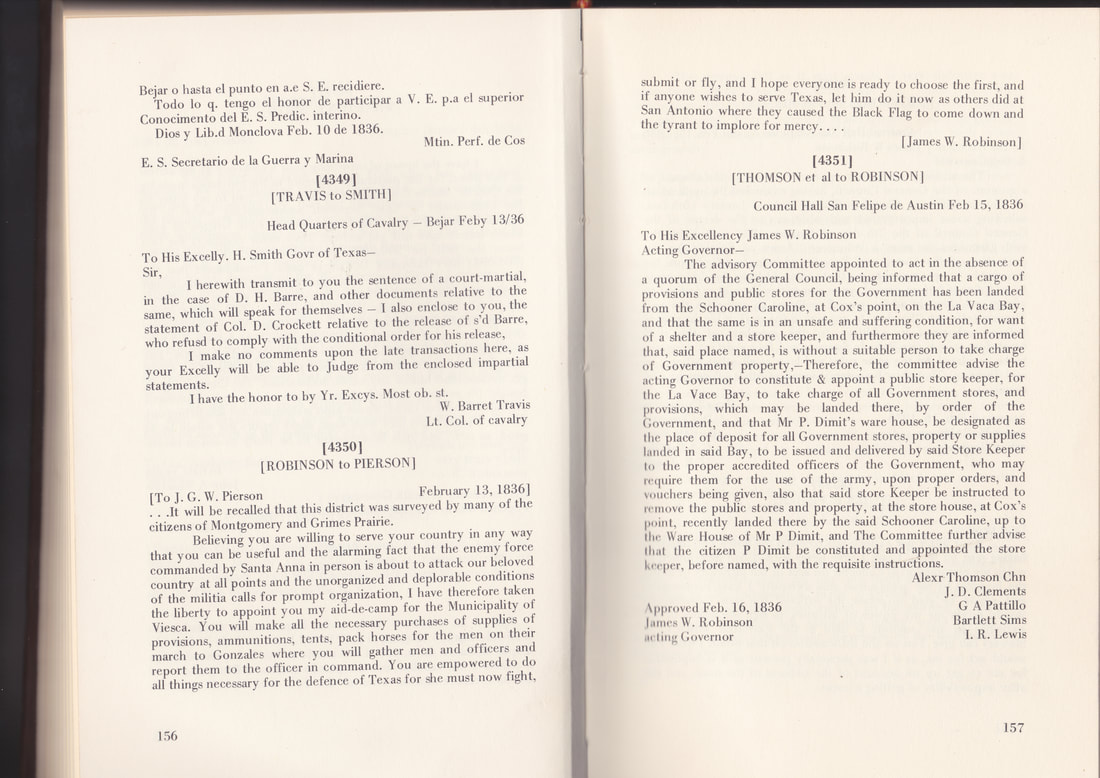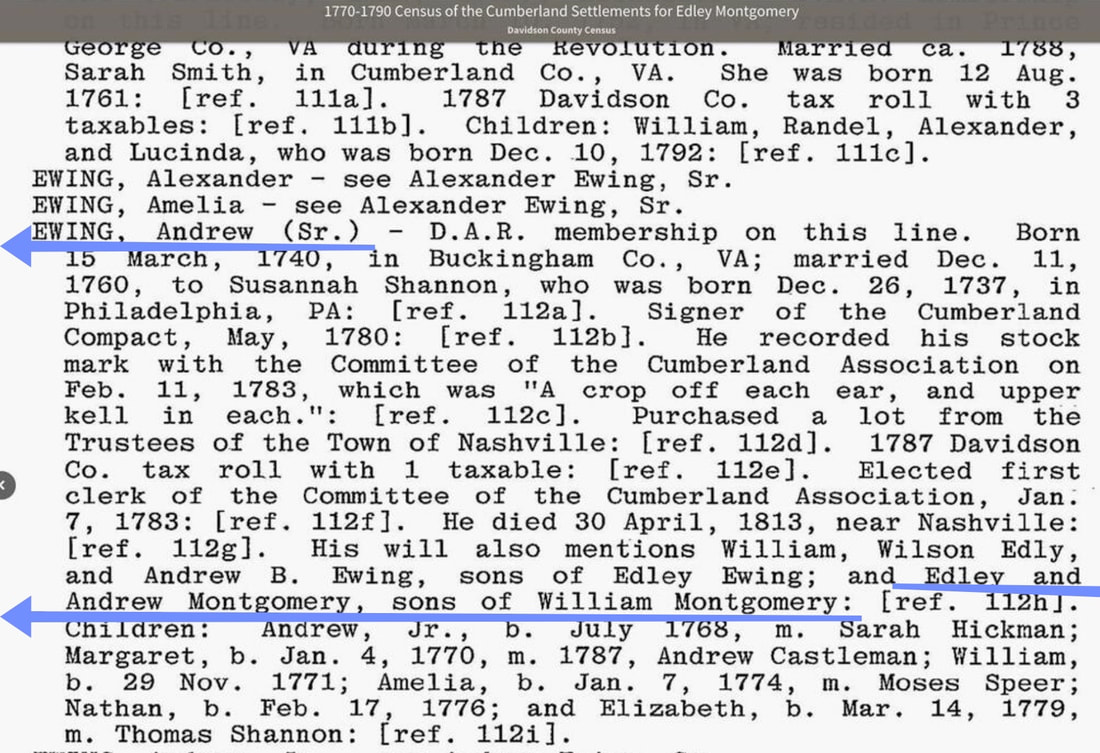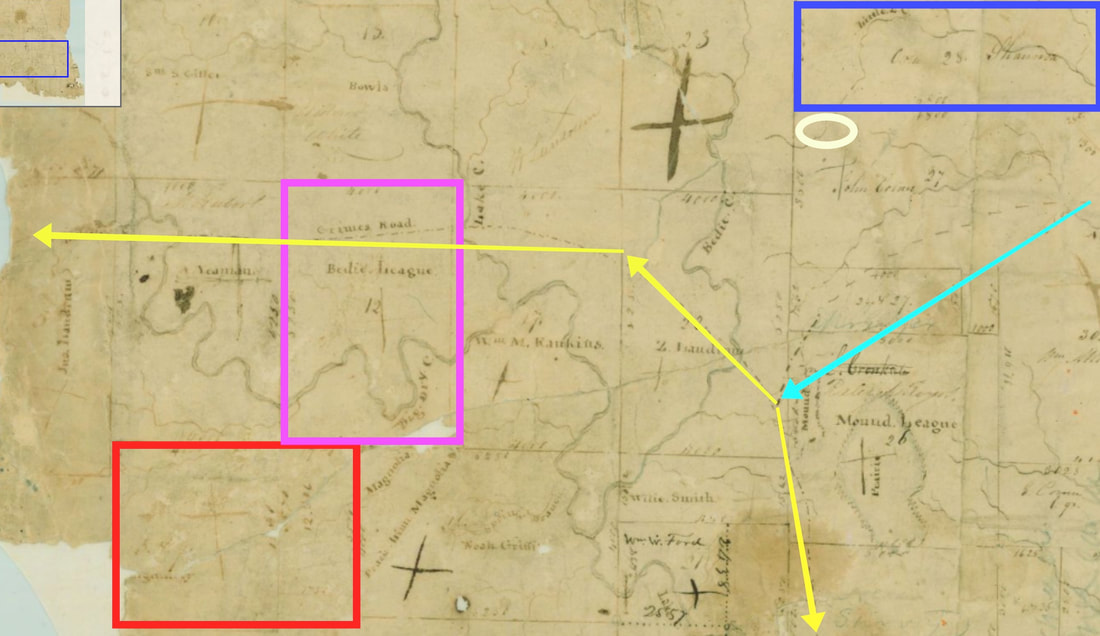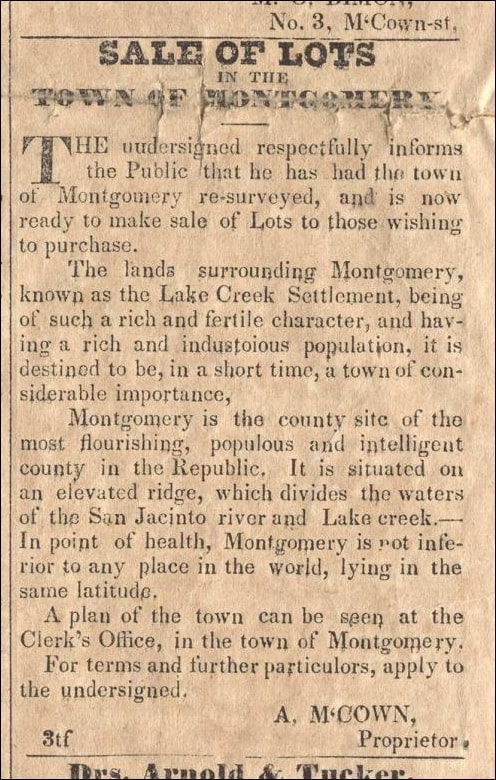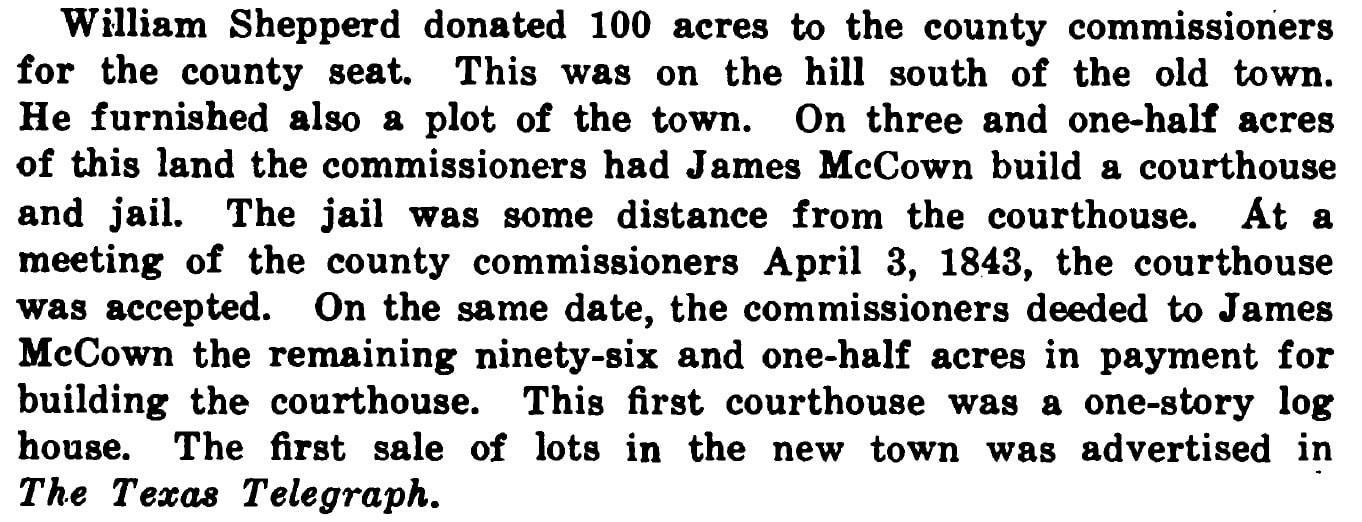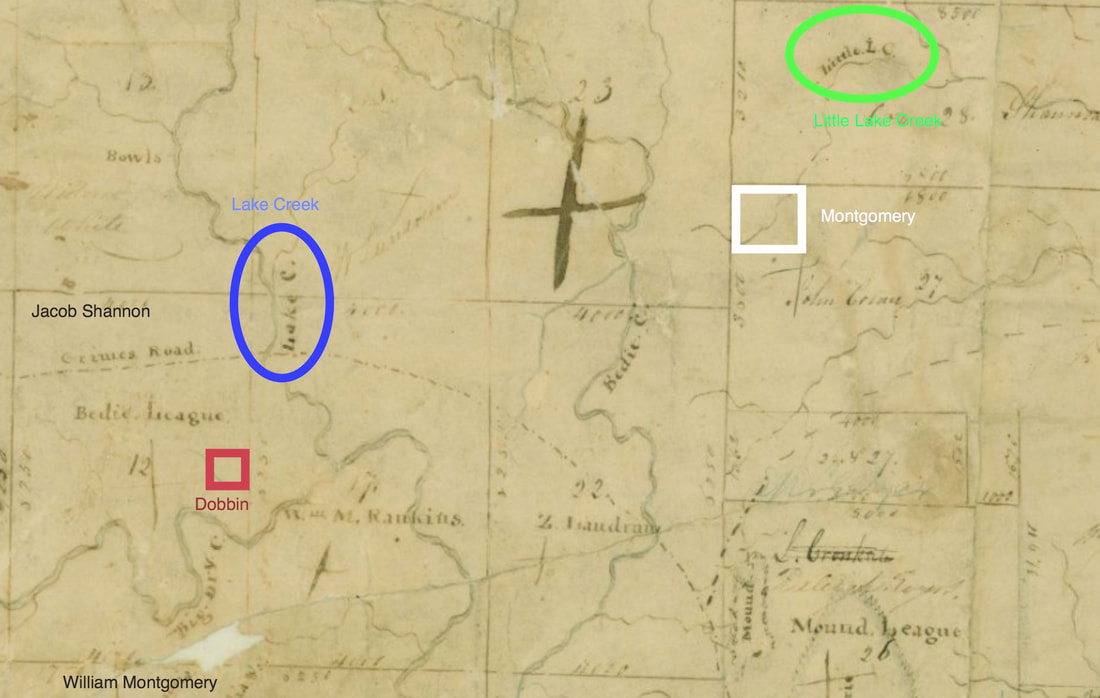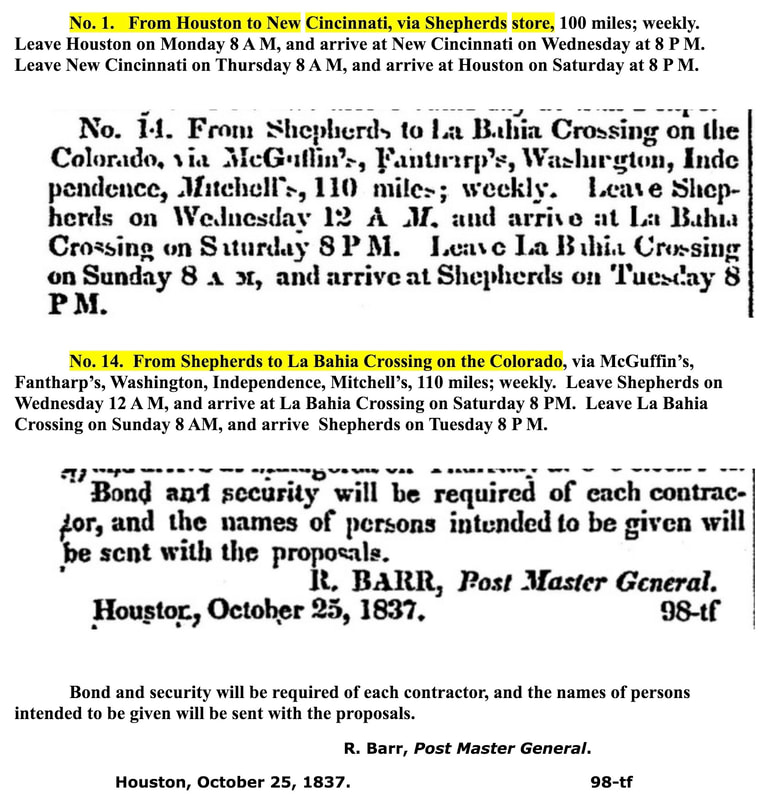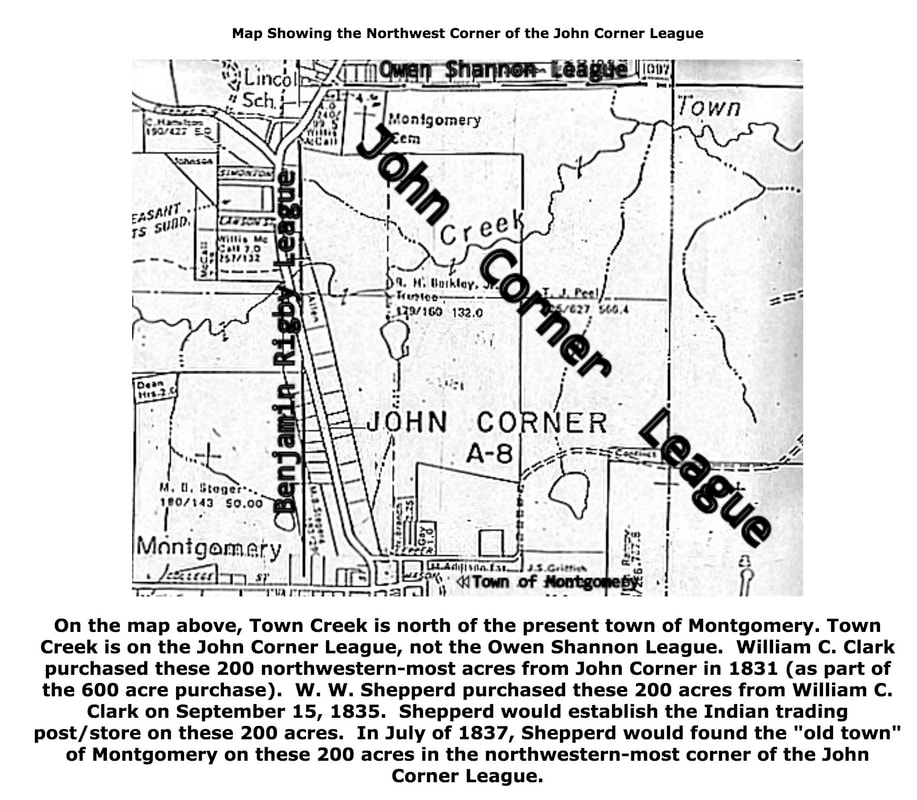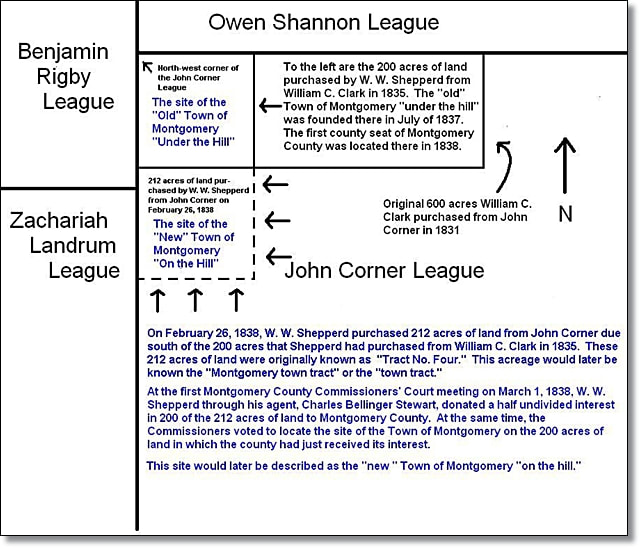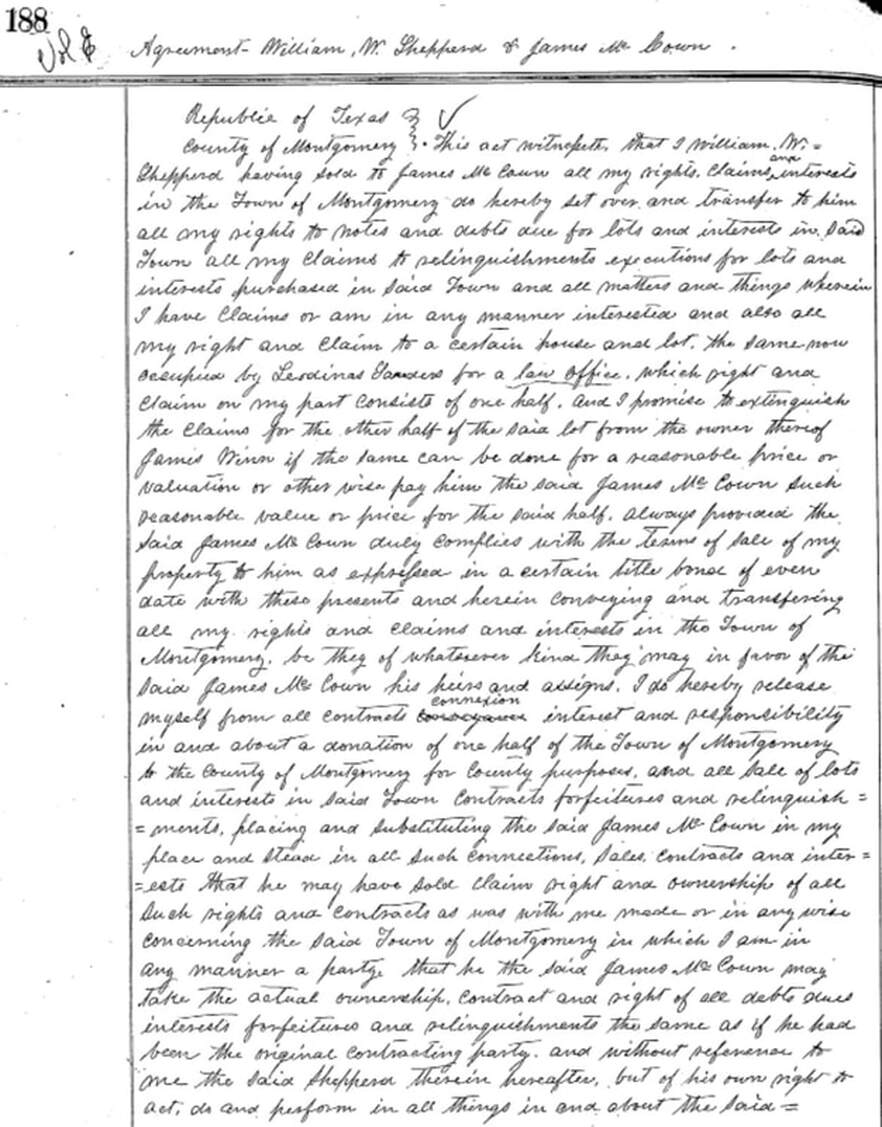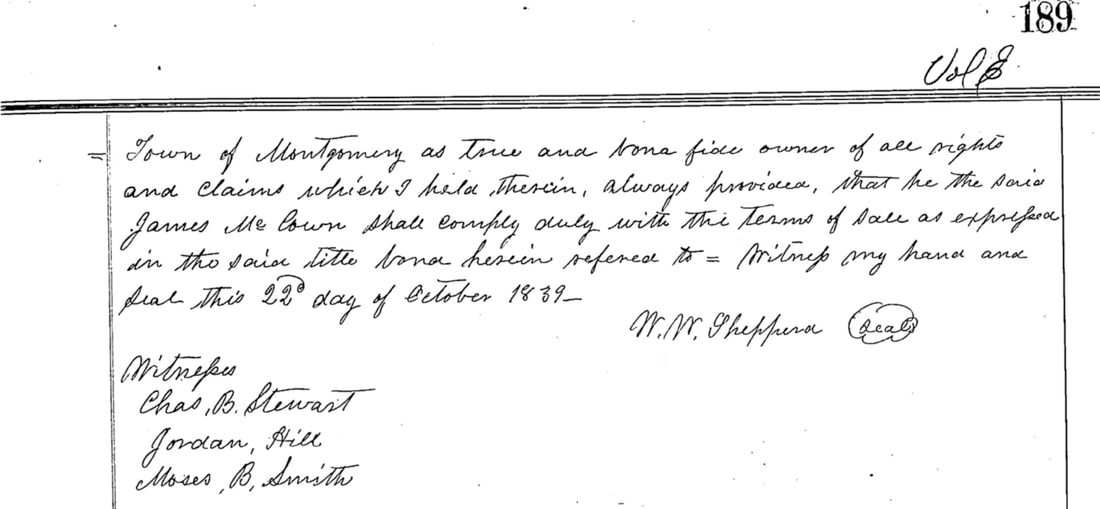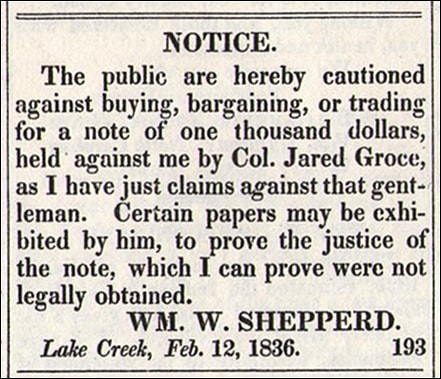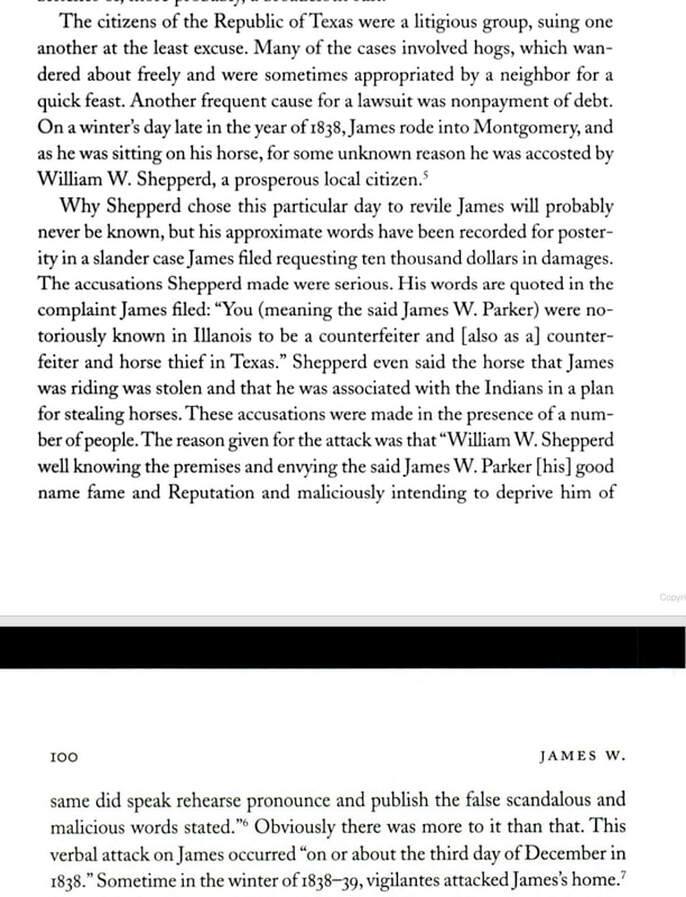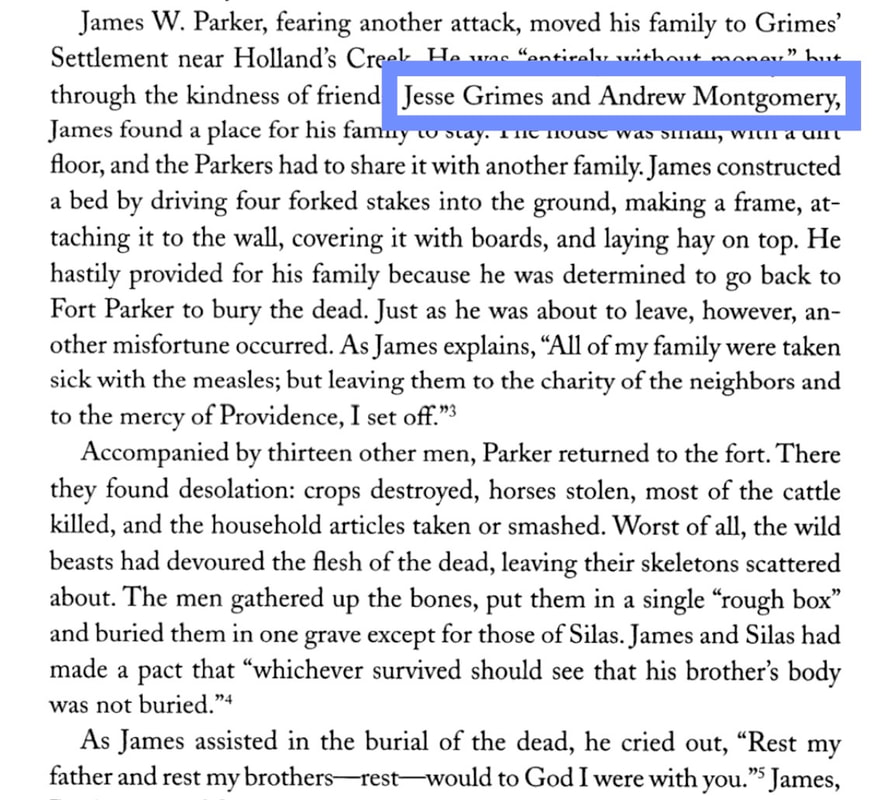Montgomery
PREAMBLE
Montgomery, Texas - est. in 1837. Claims today state that there was not a Montgomery anywhere in Texas before 1837.
Yet Montgomery Citizens were called up to fight for the Republic of Texas in 1836. Montgomerys were in the area as a part of Stephen F. Austin's Colony in 1831 and on primary documents it is stated they were in the area as early as 1819.
How can this be?
Here we explain.
Please read the following for a General Introduction and Overview:
Naming of the County of Montgomery: Question - Supplemental Sources below
July 1837 Ad for Montgomery- No where does this ad say the town is new - even Washington sold lots long after it was created...as did Montgomery.
- The county is new- the city was already extant. |
Claim for W.W. Shepperd naming the town Montgomery after his friend Moody's short lived stay in Montgomery County Alabama centers on a misplaced thesis that there was no town of Montgomery extant in Texas prior to July of 1837. Link: http://texashistorypage.com/Help_Wanted_-_Montgomery_Prairie.html?fbclid=IwAR1-yLj9WQV4MqkaEgzpjEBrwCLJPM5zlrhO0YLHAMsqiZ7S19IVBkKB8Hk
|
Claim : No Montgomery anywhere in Texas before July 1837
"No such documents exist"
Answer to the above Search:
There was a Montgomery prior to July 1837
and it was in Montgomery County
Montgomery - February 1836
Volume 9 of the Papers of the Texas Revolution on pages 156-157 calls up the citizens of "Montgomery and Grimes Prairie" in Feb 1836 through J.G.W. Pierson (William Montgomery's son in law) by the then
Governor of Texas, James Robinson.
Primary Source: PAPERS OF THE TEXAS REVOLUTION Volume 9, pages 156-157
To J. G. W. Pierson, February 13, 1836
It will be recalled that this district was surveyed by many of the citizens of Montgomery and Grimes Prairie.
Believing you are willing to serve your country in any way that you can be useful and the alarming fact that the enemy force commanded by Santa Anna in person is about to attack our beloved country at all points and the unorganized and deplorable conditions of the militia calls for prompt organization, I have therefore taken the liberty to appoint you my aid-de-camp for the Municipality of Viesca. You will make all the necessary purchases of supplies of provisions, ammunitions, tents, pack horses for the men on their march to Gonzales where you will gather men and officers and report them to the officer in command. You are empowered to do all things necessary for the defence of Texas for she must now fight, submit or fly, and I hope everyone is ready to choose the first, and if anyone wishes to serve Texas, let him do it now as others did at San Antonio where they caused the Black Flag to come down and the tyrant to implore for mercy...
James W. Robinson (Governor of Texas)
A few assumptions:
The questionable position that W. W. Shepperd's named the town of Montgomery (est. July 1837) and Montgomery County stems from several key assumptions:
1. Assumption: There was absolutely no town of Montgomery or Montgomery Prairie, Settlement, etc. in the State of Texas prior to July 1837 (see above letter of February 1836 "citizens of Montgomery" to prove this assumption wrong).
2. Assumption: The County was named for W. W. Shepperd's "Montgomery" town est. July 1837 (What Searle labels "Old Montgomery"). (see above letter of February 1836 "citizens of Montgomery" to prove this assumption wrong).
3. Assumption: W. W. Shepperd didn't know the Montgomerys existed when he supposedly named the town Montgomery. (He did and was on several documents with the Montgomerys: as early as 1835- with Margaret Montgomery Shannon on the will of Owen Shannon.)
4. Assumption: The Montgomerys were not well known or of high status in the community.(They were indeed land owners, sheriffs, Texas Rangers, county clerks, and worked to help the Parkers after the Fort Parker massacre, they helped Rachel Plummer as stated in her narrative along with neighbor Jesse Grimes. Primary documents further on this page.)
5. Assumption: The Montgomerys were not in the area of Montgomery at its naming. (They were in the area of present Montgomery as early as 1820 as Montgomery County documents will attest.)
6. Assumption: No "Montgomery Trading Post" existed because it was the "Shepperd's Store/Indian Trading Post" so he in effect does what he lambasts others for: claim what he calls "the trading post myth" for his own. Indeed to counter act this assumption- the first store was built on land that Sheppard did not own- leaving the possibility it was indeed extant before his purchase.
7. Assumption: Montgomery was named for Montgomery, Alabama where Sheppard's friend Moody briefly lived at - though Moody never owned land in the area and never settled here. Essentially this assumption states that Sheppard came into the area in 1835 - and had been here perhaps 2 years and then named it Montgomery for his friend who did not live here but who helped him to sell lots to the town. Moody had lived in Montgomery, Alabama at most a few years as it had not been in existence for more than a decade by the time he left for Texas. (The Montgomerys had been in and around the area for 17 years by 1837 and they were a very large clan at this time.)
Who was then the county named for?
W. W. Shepperd knew the Montgomerys in at least 1835
W. W. Shepperd knew the Montgomerys:
Shepperd signed not only as an appraiser to Owen Shannon's will - on the same page as "Margaret Montgomery Shannon" but also on the probate of William Montgomery's will.
See below Owen Shannon's will signed by Sheppard.
Shepperd knew the Montgomery's and quite well -early- in his stay in the area where the Montgomery's and Shannon's had been for quite some time.
The Montgomery's and Shannon's had their land grants from Stephen F. Austin in Original Montgomery county in 1831- several years before Shepperd came into the area.
MONTGOMERYS: WHO WERE THEY?!!!
Were they important?
The founders of Tennessee, Fort Nashborough
and signers of the Cumberland Compact in 1780
James Robertson, Andrew Ewing, John Montgomery
James Robertson, Father of Tennessee: Uncle of Sterling Robertson (Empresario of Robertson's Colony in Texas) and Grandfather of George Childress (author of TX Declaration of Independence)
Andrew Ewing, Keeper of Records and Indian Liaison: County Clerk, Right Hand Man of James Robertson who remained in office until 1813 and his children after him- even to the time of Sam Houston's Governorship of Tennessee.
John Montgomery, First Sheriff of Fort Nashborough Tennessee- Montgomery County Tennessee was named for him.
Andrew and Edley Montgomery, sons of William Montgomery
were the grandsons of Andrew Ewing, a founder of Tennessee
1822: Texas Association was signed by William Ewing and Sam Houston in Nashville, Tennessee
1820- Andrew Montgomery first comes to Texas
1821- Andrew Montgomery and J.G.W. Pierson listed as surveyors for Mexico. ("One League to each Wind" Sue Watkins, page 31)
1822- Clerk Returns of Montgomery County lists William Montgomery in Texas (Texas General Land Office)
1823- According to Bailey Montgomery, son of Andrew Montgomery, a Indian Trading Post was established.
1. Andrew Montgomery's grandfather, Andrew Ewing was an Indian Liaison with the Cumberland Settlements in later Tennessee.
2.William Montgomery had land near the Bedais League/Indian League (Wightman map)/Bedais Town (see Arrowsmith/Bolleart's map below).
3. In 1855, Andrew Montgomery stated he had Indian connections as an Indian Fighter - many Indian Tribes/Nations were often fighting with and against each other. Andrew would have had various alliances/and enemies.(Petition cited below in its entirety- and more below)
1830- Stephen F. Austin sits Andrew Montgomery right by his own land grant and by Jesse Grimes land grant- notice that none of the Montgomerys (William, Andrew, Edley, or John needed Character Certificates).
1833/35- Present in Sterling Robertson's Colony were Andrew Montgomery and JGW Pierson (his brother in law) and as Surveyors- In Robertson's absence, Pierson took over command.
1836- James W. Robinson, then Governor of Texas, calls upon JGW Pierson (Andrew's brother in law)- and surveyors of Robertson Colony (as Andrew Montgomery was) - citizens of Montgomery and Grimes Prairie -to come to his aid against Santa Anna.
Stephen F. Austin relied upon the indian fighters/negotiators during his tenure.
What does this mean?
The Montgomery Clan was well connected to Nashville (Sam Houston, Robertson, Ewing) as well as Stephen F. Austin (Grimes and Goodrich). They were indian fighters and indian liaisons - surveyors and trailblazers - they knew the land, knew how to fight, and knew how to trade (have a supply chain - not just set up a store in the wilderness and expect people to come but go out and make relations with the Indians, trade across to Arkansas and the state- and with enough kids/relations to "hold down the fort" while going off on jaunts such as the Miller County Petition of 1825).
Andrew and Edley are clearly Ewing Family names - the name "Edley" in particular had not been present in the Montgomery family line up until this point.
Further Meet the Montgomerys:
William Montgomery: Clerk Returns Emigrated in 1822, Stephen F. Austin's Register of Families 1830. Son-in-law to Andrew Ewing. Father of Andrew, Edley, and John here listed as well as four girls (1 married JGW Pierson, 2 married Greenwoods, and 1 married the son (John Ford McGuffin) of Hugh McGuffin, Justice of the Peace for Precinct of Viesca in 1837).
Andrew Montgomery: Son of William Montgomery, the head of his family, came into the area in 1822, A Petition of 1855 Signed and Attested to by Grimes and Goodrich that Andrew Montgomery participated in Expeditions into Texas a Early as 1820, "League to Each Wind" Andrew listed as a Surveyor for Coahuila y Texas along with Pierson in 1821, Stephen F. Austin placed Andrew Montgomery beside Stephen F. Austin and Jesse Grimes (the Primary Judge of Austin Municipality) in 1830, Land in Robertson's Colony and surveyor of Sterling Robertson's personal land grant, and aid of the Parker's in the Rachel Plummer Narrative with Jesse Grimes. Although listed as "just a private" he was nonetheless an important participant in the Battle of San Jacinto- as were all those who participated in the battle.
Edley Montgomery: Son of William Montgomery, the head of his family, came into the area in 1822, Listed on Clerk Returns in 1829, Texas Ranger.
John Montgomery: Son of William Montgomery, the head of his family, came into the area in 1822, Listed in the Clerk Returns for 1831, Land, and the Constable for the precinct of Viesca for Washington Municipality in 1837. Participant in the Battle of San Jacinto.
- Not only then were William Montgomery and Margaret Montgomery Shannon kin - but Andrew and Edley Montgomery were also Shannon descendants -
Please see below- those highlighted in blue are Montgomery kin: Greenwoods, Garrett, Shannon, Montgomery
Montgomery Family Tree in Texas and Tennessee
Shannon, Farris, Speer, Pierson, Greenwood, Gillespie, Collard, McGuffin
aWilliam Ewing b. 1710-Anne Shannon(Daughter of a Thomas Shannon*) 1711
Andrew Ewing b. 1740 (one of the founders of Tennessee as above with James Robertson and John Montgomery) -Susannah Shannon ( Daughter of a Thomas Shannon*)
William Montgomery b. 1772- m. Susannah Ewing b. 1781(- Susannah's sister Ameliah Ewing married Moses Speer Methodist Preacher who preached in Original Montgomery County and Robertson's Colony- there is a marker to him in Montgomery Texas)
- Andrew Montgomery b. April 4, 1801 - m. Mary Mahulda Farris (d. William Farris of Battle of Horseshoe Bend, Franklin Co. TN, Cumberland Settlements with James Robertson in Tennessee, brother Hezekiah Farris' cabin is in Huntsville on Sam Houston Memorial Museum grounds today).
- Elizabeth Montgomery b. 1805 - m. J.G.W. Pierson of North Carolina, see more about him above...and in "One League to Each Wind" -Elizabeth's death and burial in Cole's Settlement/Independence, he married Narcissa Cartwright, daughter of Peter Cartwright.https://tshaonline.org/handbook/online/articles/fpi16
- Mary Jane Montgomery b. 1808- m. Franklin Jarvis Greenwood (Greenwoods married into the Pool, Larrison,
- Edley Montgomery b. 1810- m. Emmaline Farris twin sister of Mary Mehulda Farris whose sister married Captain James Gillespie (of the Battle of San Jacinto). http://www.sonsofdewittcolony.org/sjvetsunitframe.htm - Edley Montgomery, though he had the measles prior to the Battle of San Jacinto, joined the the Washington County Volunteers June 30, 1836 at Washington on the Brazos, and became a part of the Texas Rangers.
- John Montgomery b. 1815- m. Elizabeth Julia Robinson (daughter of William Robinson, one of those tasked with founding the county seat of Montgomery, Fourth Regidor of San Felipe de Austin in 1810. Julia Robinson's brothers Benjamin and George fought at San Jacinto as did her sister's husbands, Job Stark Collard and James Harrison Collard- their father, Ellijah Collard, was one of the finders of a county seat for the newly formed Montgomery County). John Montgomery fought at the battle of San Jacinto and was the first Constable for the District of Viesca.
- Anna Montgomery b. 1815- m. Joel Greenwood
- Sarah Sallie Montgomery b. 1822- m. John Ford McGuffin, son of Hugh McGuffin, Justice of the Peace for the district of Viesca.
Margaret Montgomery b. 1773-Owen Shannon(Son of a Thomas Shannon)1762
- Jacob Shannon m. Catherine Kitty Yoakum (1802-1892)
- Hannah Nancy Shannon m. Charles Garrett (1801-1848) Garretts Creek
- Eleanor Shannon m. Jonas Harrison (1778-1836)
- Ruthy Shannon m. James William Miller Jr. (1792-1830)
- Polly Shannon m. John Calvin Houk (1766-1844)
Montgomery County Clerk Returns from 1838 Files 1&2
Earliest settlers in Montgomery County
Highlights with known family members of the Montgomery Family
Notice Jesse Parker just under William Montgomery in 1822.
Montgomery Clerk Returns, 1838, No. 1, 2, & 5 - Order: Date, Name - Added notes of Montgomery Clan friends and family.
1855 Primary Documents- of Andrew in Texas in 1820, Indian Fighter, and Participant in the Battle of San Jacinto.
Stephen F. Austin's Primary Judge Jesse Grimes: neighbors of Montgomery
Stephen F. Austin had a land grant placed beside Jesse Grimes in 1830- in what became Montgomery County...who else did he personally place there (without a reference certificate to show prior friendship/knowledge of him?) Andrew Montgomery the descendant of Andrew Ewing, founder of Nashville.
Notice in the below map who all is placed in the same area as Austin as appears on the list of early settlers of Montgomery County.
Note the land to the east of William Montgomery's survey was also a part of his original land grant in 1831.
Andrew Montgomery entitled to land in 1830 - Stephen F. Austin's Register of Families. Stephen F. Austin placed Andrew Montgomery personally not only next to the primary judge of the Municipality of Austin, Jesse Grimes, but also next to his personal land- as seen in the map below.
Yellow: Austin, Grimes, and Andrew Montgomery
Green: Greenwood Families (Married Montgomery girls) Montgomery Clan
Blue/Purple: Shannon and Pierson -Montgomery Clan
Red: Montgomery family (William, Andrew, Edley, and John) Montgomery Clan and Margaret Montgomery Shannon and Family (Millers, etc.)
Portion Map of Today's Montgomery County as it was in 1831
Red: William Montgomery's survey of 1831 and family survey.
Purple: "Bedie League" (As stated in the primary source), Indian League, Where the Bedias lived that soon after became Jacob's Land. It looks that it was to be a reservation- until Jacob more than likely took it for safekeeping.
Yellow: Grimes Road - Leading to Jesse Grime's homestead- by where Andrew would settle by Stephen F. Austin.
Blue: Owen Shannon's place
White: Site of Montgomery today
Montgomery County of 1837: A larger county than today
Original Montgomery County included today's Montgomery, Grimes, and Walker counties plus portions of Waller, San Jacinto, and Madison.
In 1830, the area of Original Montgomery was in the
District (Precinct) of Viesca.
Montgomery was a part of Washington County from 1836- December 1837 comprised of the 3 precincts of Viesca, San Jacinto, and Lake Creek.
Know the truth- Explore here the growth: https://publications.newberry.org/ahcbp/map/map.html?fbclid=IwAR3N3GGD4TQ-t-mct5qI1IlRn2OJuAUpeAepMCcflmTIJuBxtBfKYHeQ6cI#TX
"1841" Arrowsmith map with notes of William Bollaert
Notice on the above map by Arrowsmith written on by William Bollaert who traveled through Texas in 1841 and stayed with Jacob Shannon on the Bedais League- drew on his map the Bedais- village just southwest of Big Dry Creek and Lake Creek. This was near William Montgomery's Survey of 1831.
This might lead creedence to the Montgomery Trading Post narrative of the Montgomerys in 1823- Bedais near the Montgomery Survey, County Clerk Returns of the Montgomery Kin coming in early, Jacob Shannon's survey before his purchase was referred to as the Bedais or Indian League.
Forgotten First Settlers of Montgomery County:
William Montgomery and many others
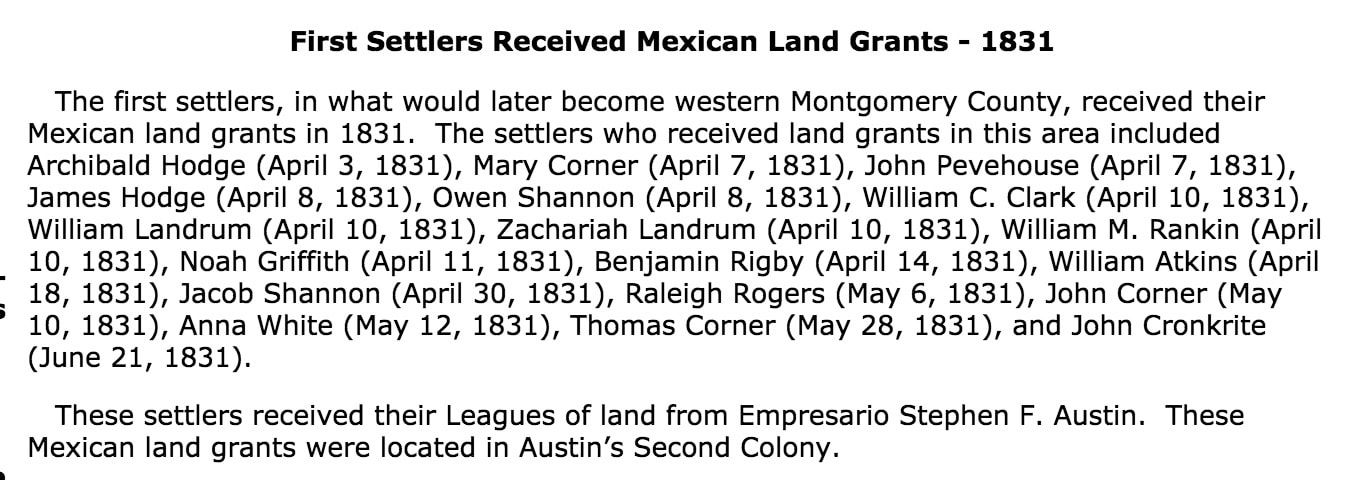
http://www.texashistorypage.com/Indian_Trading_Post_Montgomery,_Texas.html page 4 too of his book on Early Montgomery County.
Point of Information: Searle only mentions the Mexican Land Grants of today's present Montgomery County- omitting that the Original County was much larger than today. The parameters of the Original County included Grimes and Walker plus portions of Madison, Waller, and San Jacinto.
Also- he never includes that Owen Shannon's wife was a Montgomery and that by blood, Jacob Shannon was also part Montgomery. Thus his later statement "there were no Montgomery's in Montgomery county" rings true if one ONLY counts present Montgomery- which is not historically accurate.
William Montgomery's survey in Montgomery County:
Montgomery FACTS
English Field Notes: William Montgomery 5&9, 12&16 (12&16 later purchased by Margaret Montgomery Shannon and her kids) in today's present Montgomery County.
Lands surrounding Montgomery known as Lake Creek Settlement
No where in the 1837 ad does it state that Montgomery is a new town.
William Montgomery's land grant of 1831 a part of Original Montgomery County. (See above English Field Notes from 1831)
Kameron Searle's Argument on the Texas History Page is based on focusing on the Montgomery County of today- not as it was in 1837.
Kameron's argument fails to note that in 1837 Montgomery County included present Montgomery, Grimes, Walker, parts of Waller, San Jacinto, and Madison counties.
The fact that Kameron Searle on his "Texas History Page" attempts to truly demonstrate that William Montgomery did not have land in present Montgomery County lends credence to the assumption that he attempts to prove his Montgomery Thesis with the false premise that Montgomery County only ever had its present geographic borders.
Kameron Searle's "Texas History Page" and "Early History of Montgomery County" fails to note a few facts:
Above All:
1837 Montgomery County included present Montgomery, Grimes, Walker, parts of Waller, San Jacinto, and Madison counties. That is what the people of 1822-1837 knew- the Montgomery County they formed.
Feb 1836 A Primary Reference to the "Citizens of Montgomery" by the Provisional Governor of Texas to J.G.W. Pierson, son in law of William Montgomery (Vol. 9 page 158 Papers of the Texas Revolution).
W. W. Shepperd's Ad in the Texas Telegraph and Register for sale of lots in Montgomery in July of 1837 do not state that Montgomery is a new town.
Lake Creek Settlement stretched across the region as a precinct or region, not a town as is evidenced by the ad of McCowan in his sale of lots for Montgomery.
Fact 1: The Montgomerys, Greenwoods, and Shannons are listed in the Montgomery County Clerk Returns of 1838 all listed as coming into the area of Original Montgomery County from 1820-22.
Fact 2: The Montgomerys, Greenwoods, and Shannons were all Stephen F. Austin Colonists and held land officially in Original Montgomery County at least since 1831 despite being in the area since 1822.
Fact 3: W. W. Shepperd did not appear in any transactions in the area until 1834. Meaning that the Montgomerys, Greenwoods, and Shannons' residency predate Shepperd by at least a decade according to OFFICIAL Texas General Land Grant Records- Montgomery County Clerk Returns of 1838.
Fact 4: The Montgomerys, Greenwoods, and Shannons are all listed in the petitions for forming the new county that became Montgomery County because they lived in the area in question. Kameron's research has failed to pick up on this.
Fact 5: The "Citizens of Montgomery" were at least referred to by February 1836 from the Provisional Governor of Texas and as it was in writing from across the state- the reference must have been in use prior to 1836.
Fact 6: 1836 "Citizens of Montgomery" predated W. W. Shepperd's selling of lots in 1837 by at least a year and seven months.
Kameron Searle's argument for the naming of Montgomery focuses on the geographic boundaries of present Montgomery County, not the historic Montgomery County that was created in 1837.
Margaret Montgomery and Jacob Shannon as Montgomery citizens also count as blood kin Montgomery citizens.
Red is William Montgomery's 1831 grant. See the borders and parameters in the Texas General Land Office, English Field notes to William Montgomery's survey for above map.
Blue is the present border between today's Montgomery and Grimes counties, both a part of Original Montgomery County of 1837.
Northeast of William Montgomery's grant (in Red) is listed as "Indian Reserve" later given to Jacob Shannon, the son of Margaret Montgomery Shannon. This harkens to the "Indian Trading Post" legacy indeed: In 1831 this map shows William Montgomery's land grant and Jacob Shannon's as the "Indian Reserve" elsewhere "Bedie League" - this may ring true then the concept of a Trading Post early - Perhaps William was trying not to overtake the reserved league...but when it came down to it, someone had to take it: in comes Jacob Shannon.
Later, Margaret Shannon would come to move to the eastern portion of William Montgomery's original land grant in today's Montgomery county. This may harken as to why it is said that the Indian Trading post was Andrew's, William's, Jacob's, and Margaret's. Indeed they were all together, near an indian town of Bedias referred to by the league and the map of Arrowsmith/Bollaert at the Library of Congress (see above).
Assumption- Montgomerys were not in the area at the time that Montgomery was named (see the land grants of William Montgomery of 1831 above and Petition of October 13, 1837 below)
Montgomery's, Greenwoods, Grimes, and others sign the petition for the new county in October of 1837.
On Kamerons Searle's site, the scanned petition was accidentally forgotten though he had a place marker for it:
 http://www.texashistorypage.com/Creation_of_Montgomery_County,_Texas.html
http://www.texashistorypage.com/Creation_of_Montgomery_County,_Texas.html
Thus the scanned names on the petition of October 13, 1837 as Andrew, Edley, and John Montgomery as well as the Greenwoods, B. B. Goodrich, and Henry Fanthorp were not brought to light.
Petition for a new County from Washington in October 1837 - Signatures of the Montgomerys (3), Greenwood, Holland, McGuffin, Fanthorp, Womack, Goodrich, Robinson,and Grimes
Convergence of Lake Creek and Big Dry Creek
1831 Map Wightman - southwest corner seen as William Montgomery's survey, Owen Shannon's survey in Northeast of this cut out. The Bedie League just above the northeast corner of William Montgomery's survey later became Jacob Shannons survey and in later years, just to Montgomery's east was Margaret Montgomery Shannon, his widowed sister and niece.
The Bedie League or Indian League was not taken over by Jacob Shannon until after William had received his land grant in Today's Montgomery County.
Bolleart Map, Bedais, the Bedais League - east of Lake Creek and South of Big Dry Creek. Jacob Shannon's, Margaret Shannon's, and William Montgomery's Land Grants and post concepts converge with an actual Bedais town.
1841 (1839) Arrowsmith Map in the Library of Congress - with notes of William Bollaert who came to Texas and traveled in 1841 - Bollaert stayed a time with Jacob Shannon.
Note the convergence of Lake Creek, another Creek just west (Caney), and Big Dry Creek and Montgomery nestled in it...just to the south west of this is the term/a town of Bedais.
Add to that the Bedais/Indian League was at/near this juncture West of Lake Creek and South of Big Dry Creek....there by/on William's and Jacob's grant.
The Indian town that brings more to bear the tale of an Indian Trading post.
Note: Montgomery is rather far away from Atkins Creek on this map....and closer to the southern border of Montgomery - Not the Montgomery that was advertised as centrally located. Thoughts to ponder.
Convergence
This then brings the William Montgomery, Margaret Montgomery, and Shepperd claim into focus: W. W. Shepperd all theories somehow collaborate into one.
In conclusion -
1. There was a town by the name of Montgomery prior to July 1837 in Original Montgomery County.
2. The Montgomery family had been in the area of Original Montgomery County since at least 1820-1822- and had land in Austin's Second Colony in Original Montgomery County and Today's Montgomery County in 1831- William Montgomery and clan were living by the Bedais village and Andrew Montgomery was placed right by the primary judge of Austin's Colony (Grimes), and Stephen F. Austin's personal land.
3. Newcomer Shepperd in 1834/5 knew and lived/became close enough to the Shannons/Montgomery - Margaret Montgomery to sign as appraisers of Owen Shannon's in 1835 and William Montgomery's probated will in early 1838 just after Montgomery County was formed.
4. There is however no reference by Bolleart to any indian village near Clark's land grant / area bought by Shepperd - How then did Shepperd have an Indian Trading Post in 1835? (as stated by Kameron Searle? Where is his evidence?)
If the claim of Shepperd owning the first store rings true- it was a rather new store to the area and on land that had been settled for years and years by Corner and Clark prior to him.
One would think that as Grimes Road had been extant since at least 1830 (if not before, considering Stephen F. Austin was his neighboring land grant) that there would have been some kind of store/trading post before 1835.
"Old Montgomery"
Anna Landrum Davis
1921 Texas History Teacher's Bulletin
Anna Landrum Davis in 1921 after doing verbal interviews with old timers of Montgomery discussed the old theory that in 1830 - Jacob Shannon, James Montgomery, and one or two others built their homes on Town Creek.
This oral history might indeed have referred to homes Jacob Shannon had prior to his 1831 land grant on Lake Creek by Dobbin.
If there was a "Margaret" married to a "James Montgomery" then this "Margaret" would not have had the maiden name of Montgomery - or at least the chances are slim that her maiden name would have been Montgomery. There might indeed have been then a "Margaret Montgomery" (married to James) and a "Margaret Montgomery Shannon" (married to Owen). There are things in this piece to consider until we have proof against it. If there were these two Margarets then it would make the case stronger for it.
With the information of the "Montgomery County Clerk Returns" we see that Owen and Jacob Shannon, the Greenwoods, and the Montgomerys were in the area early - 1820s.
Owen Shannon at a minimum had a land grant around Town Creek/Little Lake Creek in 1830.
If what Anna Landrum Davis says is true- and what we discovered about W. W. Shepperd signing on Owen Shannon's will in 1834/5 is true...W. W. Shepperd was in an area already known for the Shannons (obviously) and indeed Montgomery's (as Margaret was a Montgomery)....as Shepperd signed as an appraiser on Owen Shannons will....again in one document we have a Shannon, Montgomery, and Shepperd.
Now prior to 1834/5 Shepperd was NOT in the picture.
That could have been at least 4-5 years in the area before Shepperd got into the picture...and more with the Clerk Return records....
William Clark was also in Texas in the 1820-1822 with the Montgomerys, Greenwoods, and Shannon's. If William Clark purchased this land from Corner early, and think of the early 1830s they could have all been running the area together before Shepperd came into the picture.
So this theory of "Shepperd owning the first store in the old town of Montgomery" does not necessarily mean that Shepperd BUILT the first store in the old town of Montgomery does it.
It seems questionable that the much spoken about "old town of Montgomery" only lasted a few months as Kameron Searle contends...used to explain that Shepperd built both towns (old and new)...
Why then was so much written and said about the "old Montgomery" in the succeeding generations if it lasted but a few months?
Where did these theories come from? Would it not be more probable that the old and new Montgomery towns were separated by more than a few months?
 Anna Landrum Davis
Anna Landrum Davis
Here then is another reference to Richard, Margaret, and James Montgomery- the family of Montgomery being the inspiration for the naming of the town and the county....harkening perhaps in Richard and Lemuel to the theories of Montgomery County Alabama.....which are also named after the members of the Montgomery Clan. Moody is not mentioned in Anna Landrum Davis' discussion.
From this committee, as seen above, the Montgomery's had connections to the following commissioners through their family: Pleasant Gray (Hezekiah Faris), William Robinson (Julia Robinson, wife of John Montgomery), Elijah Collard (whose sons also married Robinsons), Charles Garrett (married a Shannon), Joseph Bennett (lived in Montgomery prairie), B. B. Goodrich (good friend of Andrew Montgomery and Jesse Grimes), and Henry Fanthorp (Andrew Montgomery visited at least in May 1837).
William Shepperd donated only 100 acres Anna claims to the county commissioners for the county seat (after the county was named and not before). This donated land was on the hill south of the old town (that had been around since 1830 according to Anna).
The description of Anna Landrum Davis today rings true with the rediscovery of the 1831 Wightman map mentioning the Bedie League, 1831 English Field notes of William Montgomery's land grant mentioning the Indian League, and 1841 Arrowsmith map of William Bollaert mentioning the Bedais Village. The Bedias must have lived near the Shannons/Montgomerys - this villiage comes alive then again for us today and helps ring true the theory of an Indian Trading Post.
Interesting notes on the Bedias to share.
In conclusion, Anna Landrum Davis from interviews in 1921- the Montgomery of 1837 was only 84 years prior at that time...and she was speaking to people who had been there...not all is to be discounted as some say. The Davis and Landrum families lived in early Montgomery. (The Montgomery and Davis families are intermarried today).
Spirit of Togetherness:
Montgomery and Shepperd knew each other in 1835
All theories converge
- All this brings then the William Montgomery and Margaret Montgomery Shannon claims closer- the kinship - and add to that W. W. Shepperd not only knew the Montgomery/Shannons but was close enough to them to form a signature on two important documents to them...their family appraisal....the truths converge more closely than has heretofore been related.
Anna Landrum Davis is also a piece of the puzzle claiming that the Montgomerys and Shannons lived along Town Creek. In addition she cited the Bedias Village cited on Arrowsmith/Bollearts map giving newfound creedence to her tales. This creedence then can easily extend to the 1830s theory of an entire (long lived) town of Old Montgomery.
If we add to this....Kameron Searle's claim of Montgomery being "Lake Creek Settlement" as a town....("Lake Creek Settlement" mentioned first in 1833......by Jacob Shannon).....and Anna Landrum Davis saying that Jacob Shannon lived along Town Creek...
Kameron Searle's "Lake Creek Settlement"
Lake Creek, Little Lake Creek, Town Creek
Searle's claim that "Lake Creek Settlement" was a town (and not just a precinct)
Lake Creek- is in the Western portion of today's Montgomery County, by Big Dry Creek/Caney Creek.
Little Lake Creek and Town Creek is what is cited in 1831 Wightman and the 1831 Owen Shannon Survey English Field Notes to be by today's town of Montgomery.
"Lake Creek" "Lake Creek Precinct" or "Lake Creek Settlement" refers to a precinct of Washington County in 1837 and in 1833 a precinct within Austin's Municipality.
Kameron Searle alludes to the possibility that "Lake Creek Settlement" is also a town - W. W. Shepperd's town - W. W. Shepperd's store on Lake Creek - as a precursor to today's Montgomery.
Several problems stick this theory:
1. Today's Montgomery is not on "Lake Creek" - even in 1831 it was referred to as Little Lake Creek.
2. Jacob Shannon's Land grant by 1833 was just west of Lake Creek - removed from Owen Shannon's and John Corner's/W. W. Shepperd's land.
3. If despite all these facts, Kameron Searle is still correct, and "Lake Creek Settlement" referred to W. W. Shepperd's Store on Lake Creek just a half mile north of today's Montgomery....it could not refer to W. W. Shepperd's store...as Shepperd did not purchase the land from Clark until 1835.
It would follow then that "Lake Creek Settlement" aka
"Shepperd's Store on Lake Creek" or "Old Montgomery" est 1833 (before Shepperd came into the area and purchased land in 1835)
Would have had to have been started by either:
- William Clark
- John Corner
- Owen or Jacob Shannon
- James, William, or Andrew Montgomery
And not by W. W. Shepperd
Again looking at Searle's own logic why, if the long established town version of "Lake Creek Settlement", were W. W. Shepperd's town of 1835 that was also in existence in 1833 before Shepperd was here, then why of a sudden in
1837/1838 were they referring to his "Lake Creek Settlement" as "Shepherd's Store" (different spelling which was perhaps common) after Kameron's claim of a new/old town of Montgomery in July 1837 and around the time of his new town of Montgomery in 1838? Confused yet?
"Lake Creek Settlement" Town Timeline
Drawing out Kameron Searle's Theory
IF "Lake Creek Settlement" were a town and W. W. Shepperd started it all
Blue- Lake Creek
Red- Dobbin is nearer to Lake Creek than Montgomery
White- Montgomery on Little Lake Creek
Green- Little Lake Creek
Though the theory is Kameron Searle's the italics are my notations...
1833 "Lake Creek Settlement" (not on Lake Creek) is first referred to by Jacob Shannon. Shepperd was not there. Anna Landrum Davis states that the Shannons and Montgomerys were around "old Montgomery" in 1830 not Shepperd.
1835 W. W. Shepperd moves to "Lake Creek Settlement" (how could he start the town if it existed before he was present?)
1835 W. W. Shepperd started "Shepperd's Store on Lake Creek" (that wasn't on Lake Creek if Kameron's placement is correct)
July 1837 W. W. Shepperd creates the Old Town of Montgomery where his "Lake Creek Settlement" town once was...
October 25, 1837 the Postal Route/Stagecoach route conspires to skip over the town name of "Lake Creek Settlement" and the new/old "Montgomery" to call Shepperd's town "Shepherd's Store"
1838 - W. W. Shepperd decided to create a third town - the new town of Montgomery- a half mile away from the old town of Montgomery (that lasted a few months) that used to be "Lake Creek Settlement" town.
So in conclusion, W. W. Shepperd not only founded the old and new towns of Montgomery but also "Lake Creek Settlement" that was in existence before W. W. Shepperd was here.
At least all those years that "Lake Creek Settlement" was in existence prior to Shepperd's coming - according to Kameron Searle- no one thought to build a store or Indian Trading Post until Shepperd came along in 1835.
W. W. Shepperd did all of this, plus kindly naming old/new Montgomery for his best friend Moody's short stay in Montgomery County Alabama (that had been in existence maybe a decade or so and was not the capital of Alabama until 1846- almost a decade after the founding of W. W. Shepperd's old/new Montgomery) according to Kameron Searle.
Note: Moody, who Montgomery was named for didn't live in any of W. W. Shepperd's towns.
Also interesting to note from Gandy's Thesis on Montgomery
From Gandy's Thesis.

